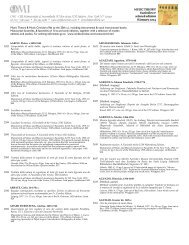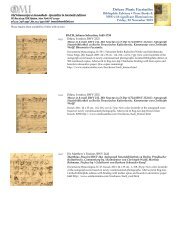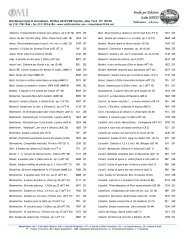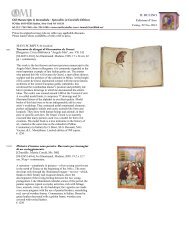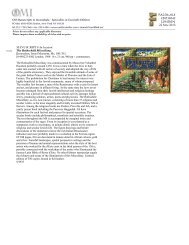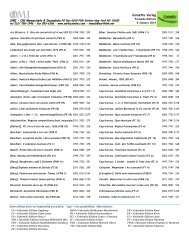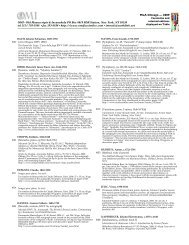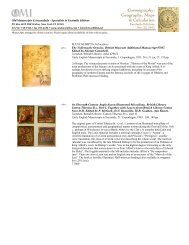CIMA 63 Titel Inhalt
CIMA 63 Titel Inhalt
CIMA 63 Titel Inhalt
Sie wollen auch ein ePaper? Erhöhen Sie die Reichweite Ihrer Titel.
YUMPU macht aus Druck-PDFs automatisch weboptimierte ePaper, die Google liebt.
18<br />
The second chapter (fols 293vb-294r) is particularly obscure. It consists of a text<br />
opening Pytagores, Ptholome und ander meister die schribent… (fol. 293vb) and a<br />
table containing the letter-number equivalents and the planet-number equivalents (like<br />
in the Sphere of Pythagoras), and series of numbers, whose meaning is not clear.<br />
Onomancy is also used in a chapter dealing with the planets (see section 4.3, below).<br />
4. Tract on the 7 planets<br />
(fols 253r-274va and 319v-323v)<br />
This section is made of four distinct parts:<br />
4.1. An almanach (fols 253ra-265v), or a set of tables giving the position of the five<br />
planets (Saturn, Jupiter, Mars, Venus and Mercury) in the signs of the zodiac at<br />
intervals of five or ten days for a period of recurrence starting in 1340 A.D. This period<br />
of recurrence, different for each planet (1340-1399 for Saturn, 1340-1423 for Jupiter,<br />
1340-1419 for Mars, etc.), corresponds to the one commonly found in medieval<br />
astronomical tables. 11 The Sun and the Moon are not taken into consideration here<br />
because the computation of their position is provided in the computus section, as<br />
reminded here in the introduction (fol. 253ra: Die andern zwen Sonne und Mone die<br />
findet man gewonlich yn guten ka lenden…).<br />
The presence of this almanach in the ‗Tübingen Book‘ is problematic for two reasons.<br />
First, the position of the five planets is not needed for the elementary astrology exposed<br />
in the work. Secondly, the almanach is ill-adapted to the middle of the fifteenth<br />
century, since it was set up for a limited period of time starting in 1340. It could be<br />
used in the fifteenth century, but, in this case, it would require complex calculations<br />
involving adjustments which are provided nowhere (see the introduction to the<br />
almanach, fol. 253ra-253vb).<br />
4.2. The ‗children of the planets‘ (fols 266va-272r). This section has made the<br />
‗Tübingen Book‘ famous among art historians, because it preserves one of the earliest<br />
representations of the ‗children of the planets‘, i.e. illustrations showing each of the<br />
planets, together with the type of men and women he/she rules. 12 The characteristics,<br />
Pythagoras‘, in Popular and Practical Science of Medieval England, ed. L. M. Matheson, East<br />
Lansing (Mich.), 1994, pp. 123-139.<br />
11 On astronomical tables and almanachs, see e.g. Emmanuel POULLE, Les sources<br />
astronomiques (textes, tables, instruments), Turnhout, 1981. Id., Les tables alphonsines avec les<br />
canons de Jean de Saxe, Paris, 1984. José CHABÁS and Bernard GOLDSTEIN, Astronomy in the<br />
Iberian Peninsula: Abraham Zacut and the Transition from Manuscript to Print, Philadelphia,<br />
2000.<br />
12 See especially Jean SEZNEC, The Survival of the Pagan Gods… (as n. 2 above). Raymond<br />
KLIBANSKI, Erwin PANOFSKI and Fritz SAXL, Saturn and the Melancholy. Studies in the History<br />
of Natural Philosophy, Religion and Art, London, 1964. Gwendolyn TROTTEIN, Les enfants de



